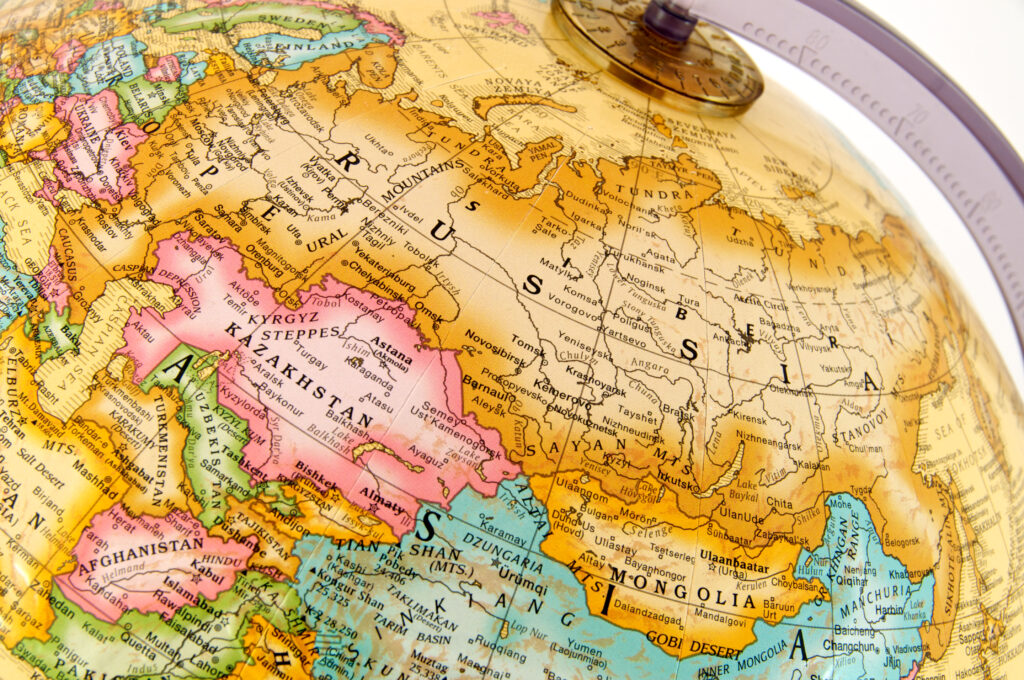Analyses
17 July 2025
What Geopolitics for the Post-Soviet Space in 2025?

Moscow’s expulsion of tens of thousands of Central Asian migrants has provoked the wrath of its five former Soviet Central Asian republics; Tbilisi shaken by a controversial “foreign agents” law; nearly 100,000 Armenians from Nagorno-Karabakh fleeing into exile; Azerbaijan cancelling all cultural events organised with Russian institutions in response to a police raid on the Azerbaijani diaspora in Yekaterinburg; Ukraine still engulfed in the war of attrition waged by Russia… These recent shocks reflect the profound transformations under way in the post-Soviet space since 2022, and especially in 2025. More than thirty years after the collapse of the Union of Soviet Socialist Republics (USSR), this heterogeneous ensemble is undergoing major geopolitical reconfigurations, between ruptures and continuities.
Reshaping of Alliances and Dependencies
Since the collapse of the USSR, alliances within the former Soviet space have been repeatedly shaken: between 1991 and 2014, 2014 and 2022, and from 2022 to the present. In successive phases, Russia, the USSR’s heir, has used various strategies, oscillating between soft and hard power. Yet it is no longer the only gravitational centre for its neighbours. China, the European Union, the United States, and Turkey must now be reckoned with. Certainly, Moscow seeks to preserve its influence through formal alliances such as the Collective Security Treaty Organisation (a military alliance led by Russia) or the Eurasian Economic Union. However, these frameworks struggle to curb the progressive emancipation efforts of several states.
Since 2022 and the invasion of Ukraine, examples have abounded. Armenia—traditionally a Russian ally—has expressed its dissatisfaction with Moscow’s inaction during the Nagorno-Karabakh conflict and even refused to host Russian military exercises in 2023. Kazakhstan is pursuing a “multi-vector” foreign policy, maintaining ties with Russia while deepening its relations with China, Turkey, and the West. Recent tensions—such as Russia’s crackdown on Central Asian workers (nearly 85,000 deportations in the first half of 2024, a record)—have triggered cautious diplomatic protests from Central Asian states. These countries are beginning to understand that their economic dependence on Moscow (migrants, trade, energy) can encounter hostile responses from the Kremlin, prompting them to diversify their partnerships.
In parallel, new powers are gaining prominence in the region. China is now a key player: it is investing massively in Central Asia through the Belt and Road Initiative, hosting exclusive summits with the five Central Asian republics and becoming an essential trade partner. Turkey, relying on its Turkic cultural ties, is also extending its influence from the Black Sea to the Central Asian steppes. Ankara actively supports Azerbaijan—its historical and energy ally—and promotes the Organisation of Turkic States as an alternative forum for regional integration. Moreover, the European Union (EU) and the United States are intensifying their engagement: the EU has recently granted candidate status to Ukraine, Moldova (and even Georgia at the end of 2023, under conditions), and is playing a mediation role in the Caucasus, while Washington hosted an unprecedented summit in 2023 with the five Central Asian presidents. Thus, the post-Soviet space is becoming multipolar, crisscrossed by rival influences, with Russia having to compete with China, Turkey, and the West to retain its allies.
Diverging National Trajectories
If we examine the evolution of the fifteen states born from the Soviet Union, it becomes clear that their political and geopolitical paths have diverged sharply. At one end, the Baltic States (Estonia, Latvia, Lithuania) quickly integrated into the Western fold: democracies and EU and NATO members since 2004, they are in 2025 at the forefront of support for Ukraine and hardline positions against Moscow. At the opposite end, Belarus has remained Russia’s closest ally, sinking since 2020 into an almost fusion-like dependency—Minsk has even accepted the deployment of Russian nuclear weapons on its soil and sacrifices part of its sovereignty to preserve Alexander Lukashenko’s authoritarian regime.
Between these poles lies a constellation of hybrid paths. Ukraine symbolises the sharpest rupture: after two pro-democracy revolutions (2004, 2014) and especially since the 2022 Russian invasion, Kyiv has irreversibly distanced itself from the Kremlin’s orbit. In the midst of a war for survival, Ukraine has asserted itself as a nation firmly oriented towards Europe, having secured EU candidate status and close cooperation with NATO. Neighbouring Moldova is on a similar path: long torn between Russian influence and European aspiration, it has chosen the Western camp under Maia Sandu’s reformist presidency, despite internal pressure from pro-Russian regions like Transnistria and Gagauzia.
The South Caucasus presents a more contrasted picture. Georgia, a forerunner of a pro-Western orientation in the 2000s, is now grappling with domestic political turbulence. While its population largely aspires to join the EU and protests vigorously against any authoritarian drift (as shown by the outrage over Russian-style “foreign agent” legislation), the ruling party remains ambiguous, combining pro-European rhetoric with conciliatory gestures towards Moscow. Armenia, long aligned with Russia for security reasons, has seen its certainties shaken by Moscow’s perceived abandonment during the Nagorno-Karabakh conflict. After a swift defeat in 2023 by Azerbaijan (backed by Turkey), Yerevan is distancing itself from its Russian protector and seeking new guarantees from the West while negotiating a difficult peace deal with Baku. Triumphant Azerbaijan is strengthening its strategic partnership with Ankara and positioning itself as an emerging power in the Caucasus, buoyed by oil wealth and military victories. A powerful symbol: the two South Caucasus states are currently negotiating a peace agreement—without Russia. This is unprecedented and emblematic of Russia’s declining regional influence.
In Central Asia, the five former Soviet republics are advancing each along a subtle balance. Kazakhstan and Uzbekistan, regional heavyweights, maintain relative autonomy from Moscow by multiplying partnerships (China, Turkey, the West) without openly breaking with Russia. Kyrgyzstan and Tajikistan, smaller and economically and militarily dependent on Russia, remain tethered to Moscow’s alliance, although they welcome Chinese investments and international aid. Turkmenistan, the most isolated country, continues its autarkic course of “permanent neutrality”, selling its gas to whoever will buy it (mostly China) while avoiding any binding alliance. Thus, thirty years after the USSR, the post-Soviet space is no longer monolithic: it contains fully Westernised democracies, authoritarian regimes subordinated to Moscow, and numerous intermediary states playing several sides to safeguard their interests.
The War in Ukraine as a Catalyst for Regional Dynamics
The 2022 invasion of Ukraine has acted as a true catalyst for geopolitical transformations across the post-Soviet space. On one hand, this large-scale conflict—the most destructive in Europe since 1945—has abruptly refocused global attention on a region long seen as peripheral. Faced with Russian aggression, Western countries have multiplied initiatives to dissuade other post-Soviet states from backing Moscow and to anchor them in a rules-based international order. The massive sanctions imposed on Russia have had cascading effects on its neighbours, pushing them to seek economic alternatives (new trade routes bypassing Russia, diversified energy sources and export markets). Kazakhstan and Uzbekistan, for example, have coordinated efforts to develop the Trans-Caspian corridor to Azerbaijan and Turkey, reducing their reliance on Russian transit. Similarly, the EU has stepped up energy cooperation offers to countries like Azerbaijan (to offset Russian gas) and Turkmenistan, reshaping regional trade flows and partnerships.
On the other hand, the war in Ukraine has seriously eroded Russia’s strategic prestige within its former empire. The Russian military—once considered formidable—has shown clear limitations on the Ukrainian battlefield. This has not gone unnoticed among other post-Soviet states. Many have taken stock of Moscow’s relative decline and its entanglement in a protracted conflict, reducing its ability to project power elsewhere. This new context has encouraged bolder moves: Central Asian leaders now engage more freely with Washington, Brussels, or Beijing with less fear of Russian reprisals; Armenia dared to organise military exercises with the United States; Georgia’s civil society, despite its cautious government, leans increasingly towards the West. The once benevolent neutrality of several countries (such as Kazakhstan or Uzbekistan) towards Russia has shifted into diplomatic distance: condemnation of territorial annexations in Ukraine in UN votes, assertions of territorial integrity, and polite refusals to participate in sanctions circumvention. In this respect, the war in Ukraine has hastened the redefinition of loyalties and regional strategies. It has highlighted the urgency for each state to ensure its own security—either by bolstering domestic capacities or by seeking new external guarantors (alliances with other powers, applications to the EU or NATO, etc.).
Soviet Legacies Still at Work
Despite these rapid changes, many legacies from the Soviet era continue to shape the region’s geopolitics. The USSR left behind a dense network of infrastructure, connections and practices whose imprint is still visible in 2025. On the energy front, for example, pipelines and electrical grids built before 1991 still link several post-Soviet states. Central Asian gas still partly transits through Russia; the power grids of Belarus, Ukraine and the Baltic states were historically interconnected with Moscow’s (although Ukraine and Moldova synchronised with the European grid in 2022, and the Baltics are progressively detaching). Similarly, roads and railways designed at the scale of a unified empire constrain regional trade: some landlocked republics still depend on transit through neighbours (e.g. landlocked Tajikistan relies on corridors through Uzbekistan and Kazakhstan for commerce).
The Russian language constitutes another enduring legacy. Thirty years after the USSR’s demise, Russian remains the lingua franca for communication among many peoples of the former empire. It is still an official or widely used language in countries like Kazakhstan, Kyrgyzstan and Belarus, and remains a professional asset (notably for the millions of Central Asian migrants in Russia). Although the status of Russian is declining in favour of other languages (English, Chinese, Turkish, or reinforced national languages), this linguistic legacy preserves a certain post-Soviet cultural space. Moreover, the political and security elites of several states are still partly shaped by the Soviet or Russian mould. Military academies in Moscow and St. Petersburg continue to train young Central Asian officers; local intelligence services are often direct descendants of the Soviet KGB; and much of the military equipment in post-Soviet armies originates from Soviet or Russian stock, creating dependencies in maintenance and spare parts.
Finally, unresolved historical disputes dating back to the Soviet era continue to weigh on regional stability. Arbitrarily drawn borders have left minorities outside their original republics, fuelling persistent conflicts (such as in Moldova with secessionist Transnistria; in Georgia with Abkhazia and South Ossetia, occupied by Russia; or in Central Asia with border disputes between Kyrgyzstan and Tajikistan in the Ferghana Valley). These so-called “frozen” or intermittent conflicts serve as reminders that the fragmentation of the USSR did not instantly erase internal ties or fault lines—they represent a problematic continuity, sometimes reignited or abruptly resolved by the war in Ukraine (as in the case of Karabakh, now brought back under Azerbaijani control).
In 2025, the geopolitics of the post-Soviet space oscillate between profound change and persistent inertia. The regional order is no longer exclusively dominated by Moscow: new balances are emerging, driven by the sovereign choices of states and the competing influences of emerging powers. Alliances are being reshaped, as a weakened Russia struggles to maintain its sphere of influence, while neighbours explore other horizons (China, Turkey, the West). National trajectories have never been so varied, from Kyiv and Chisinau’s Western turn to Minsk’s isolation, and the cautious balancing acts of Baku and Astana. At the same time, Soviet legacies—whether infrastructural, linguistic or sociopolitical—serve as reminders that thirty years is little in the scale of history. The ongoing war in Ukraine has crystallised these dynamics, accelerating ruptures and deepening tensions, potentially ushering in a new era in which the post-Soviet space is no longer viewed as a homogeneous sphere under Russian influence, but as a plural, open region subject to the winds of global multipolarity.

